Facebook ads require careful planning and implementation to be successful and deliver great ad performance.
With more than 1 billion people on Facebook, there’s no limit to the opportunities you can unlock with the right advertisements.
With the right ads, you can reach your target audience, drive better connections, and even turn one-time customers into repeat clients.
If you’re wondering why, after weeks of crafting what seemed to be the perfect campaign, you’re not getting results, you’ve come to the right place.
Here, we’re going to cover some of the leading factors that affect ad performance, and what you need to do to boost your outcomes.
Ad Performance Issues: The Factors You Can Control
There are factors you can control that affect your ad performance, and factors you can’t.
When you’re trying to increase your ad outcomes, it makes sense to start with the things that you have the most influence over.
- Ad Copy
Your Facebook ad copy is crucial to introducing both your brand and your offer to your target audience. The words you use need to make the right impression instantly. If your copy doesn’t deliver the right information to your audience, you’re not going to get results. This means you need to think carefully about:
- Language: You need to make sure that you’re speaking your customer’s language. Avoid any complicated technical speak or jargon.
- Length: Too much content can be overwhelming. This is particularly true on a social media ad, where customers are expecting quick snippets of information. Compare the length of this HootSuite ad to the one next to it:

- Grammar and spelling mistakes: Have someone proofread or check your ads if you’re worried about spelling.
- Focus: Get the point of your message across straight away. Include your value proposition within the first couple of words. You can even use bolding and different fonts to draw attention to key points like Lessonly does here:
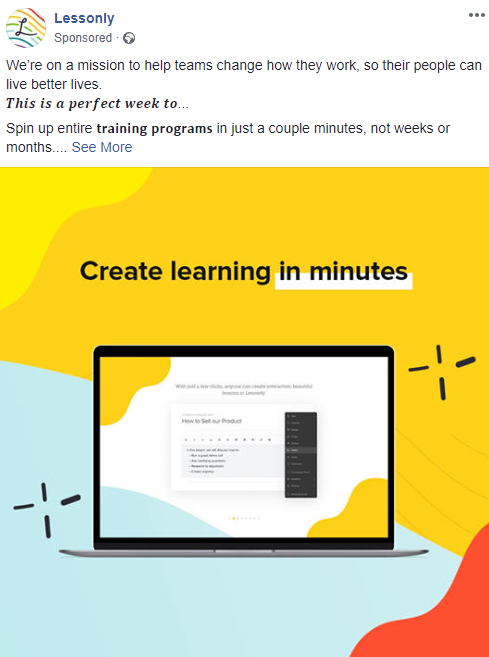
Remember, mid-to-long length ads provide the lowest click-through rates and fewer leads. However, if you create copy that’s engaging, professional, and concise, you’ll get better results. Don’t be afraid to experiment with things like font changes and emojis to grab attention.
- Ad Creative
Facebook Ads come in all shapes and sizes You can add videos to your content to deliver more information without overwhelming your audience. One excellent option is attracting your customers with images. Look at this example from Tableau Software’s ad library:

Importantly, the company uses multiple versions of its images to attract different customers.
If you’re not sure whether your ad creative is working, try experimenting with different images, or new assets, like video. If a certain asset seemed to work for a while then lost its appeal, the issue could be with ad fatigue. This is what happens when your audience sees your ad so many times, they end up scrolling right past it.
Tableau offers multiple different ads to attract audiences interested in different parts of their software and business:

Remember, experiment with different kinds of ad creative, from multiple images to videos and infographics. At the same time, make sure that you create different versions of similar ads so that your customers don’t get bored with your promotions:
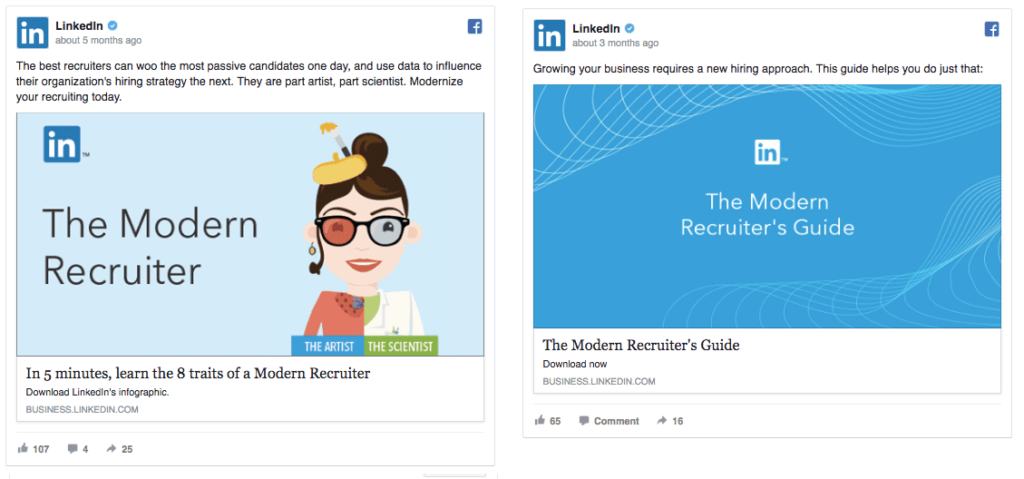
- Landing Pages
Your Facebook ads don’t generate conversions on their own.
To drive positive outcomes for your business, you need to send your audience to a landing page that convinces them to take the next step in their journey.
Unfortunately, sending someone to the wrong landing page could mean that you don’t get the right results. The first thing you need to do when designing the right landing page is to make sure that it delivers what your customers expect.
With this Facebook ad, Magaya Software promises that you can instantly calculate a potential ROI from using a new tool:

When a customer clicks on the ad, they’re taken to a landing page that delivers that promise:

To make your landing page successful:
- Ensure it’s easy for your customers to see what they need to do next. An above-the-fold CTA and a clear header can help with this.
- Highlight the benefits immediately. Let your customers know what they’ll get if they click on your ad and deliver on that promise.
- Make sure your pages load fast. Don’t risk losing your target audience because your pages load too slow.
- Ad Placement
One of the things that makes Facebook ads so appealing to marketers, is that they’re highly versatile. Your choice of ad placement ranges from putting your ads in Facebook Messenger, to having them appear on the side of the newsfeed.

Your choice of where to place your ad will have a significant impact on the results of your campaign. Using the wrong placement for your ads can limit your ad performance because different customers respond to different kinds of ads.
To figure out if your ad performance is suffering from issues with placement, go to the Ads Manager section on Facebook to check the placement of your ads.
Facebook ads automatically default to using all placements, so you get maximum exposure. However, you can switch away from this if you prefer.

Facebook suggests specific placements that you can try depending on your campaign objectives. For instance, if you’re trying to get traffic, it will help to use Facebook, Messenger, and the Audience network.
- Targeting
Targeting is a big part of determining whether your ads will be successful or not. Facebook is excellent at offering a range of great targeting options. You can target custom audiences that you create yourself based on things like a person’s interests, or hobbies. Look at this example of a weight-loss targeted ad:

If you’re not targeting the right audience, then your ads aren’t going to get clicks. In the case of the ad above, the company wouldn’t get any clicks if it were targeting people who weren’t interested in losing weight.
Squarespace uses targeting on Facebook to directly reach out to people who are also business owners, or entrepreneurs.
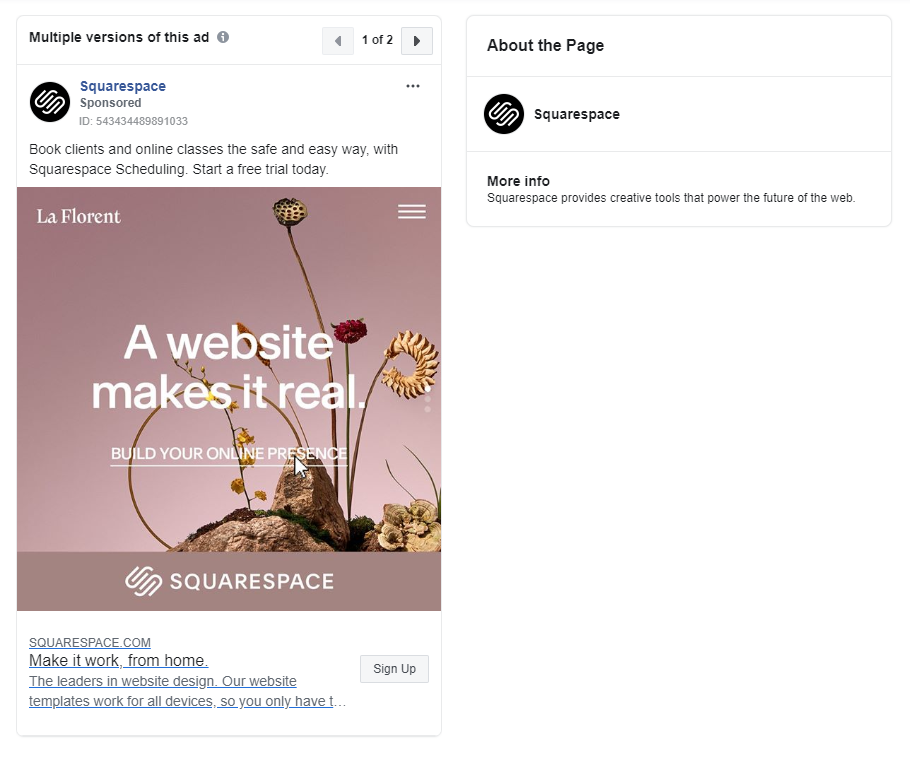
To see if targeting is a problem, head to the targeting section on your Facebook ads manager. If you’re not using a lot of filters to narrow down who you need to reach, now might be the time to expand.
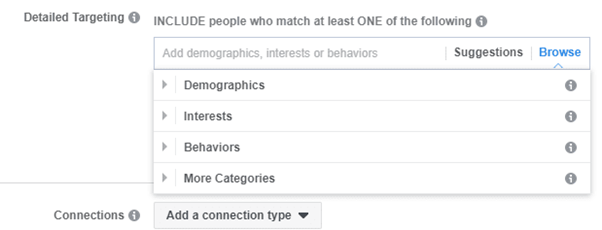
- Reach / Audience Size
Reach, and audience size is another major issue to consider.
It’s best to target no more than between 500,000 and 1 million people.
Although you want to have a good reach to ensure that you have lots of opportunities to sell, you also need to make sure that you’re not going over the top with your audience size.
Remember, the more specific you can get with your ad campaigns, the better.
For instance, when advertising to different business owners, and entrepreneurs, Squarespace can use different images and ad copy depending on the kind of business their client might run:
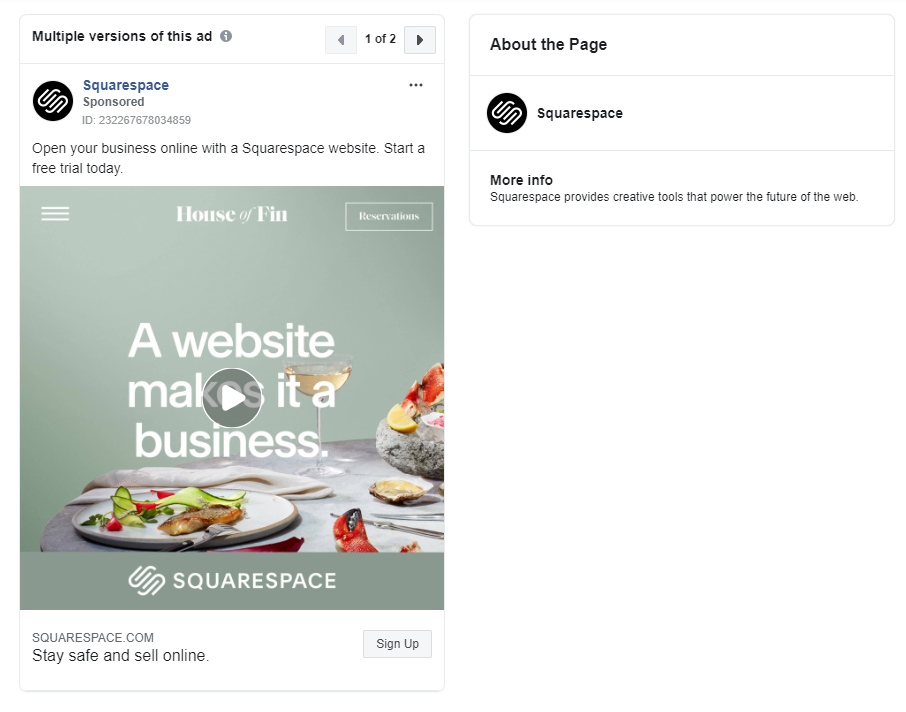
Experiment with different reach options and audience sizes to see which works best for you.
- Offer and Product
Facebook ads generally come with an offer to convince your customer to click through and do something. Part of making sure that your advertisements work is ensuring that you have the right offer in place to entice your audience.
Think about the products or services that you’re advertising.
What about this service is going to appeal to your audience?
In this case, Wix is offering clients a chance to learn how they can create a marketing portfolio to “win clients over.” The value of the product is the ability to earn more clients.

When you’re designing your product or ad offer, think about what’s relevant to your target audience.
Consider the conversations that your sales teams have with customers and the kind of things your marketers have learned by examining the market. To help, you can even use Facebook to check your Relevance Score. This score delivers a number between 1 and 10 that shows how relevant your ad is to your audience’s interests.
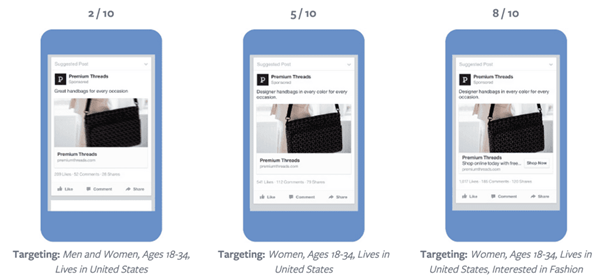
- Brand Reputation
The issue with your ad might not be in the copy or the content of the ad. Instead, it might be that your customers just aren’t comfortable enough with your brand yet.
If you’re a new company without much heritage in your field, then you may not be totally trustworthy in the eyes of your visitors.
One option to earn more trust from your audience is to consider whether you’re following Facebook’s terms of service.
You might also need to think about how you’re advertising yourself outside of Facebook. For instance, Malware Bytes promises its customers that they can access a fast and secure VPN:

The company also works on generating the same trust outside of Facebook, with an active website, complete with blog posts. There are Wiki entries for the company, Google My Business information, and more:
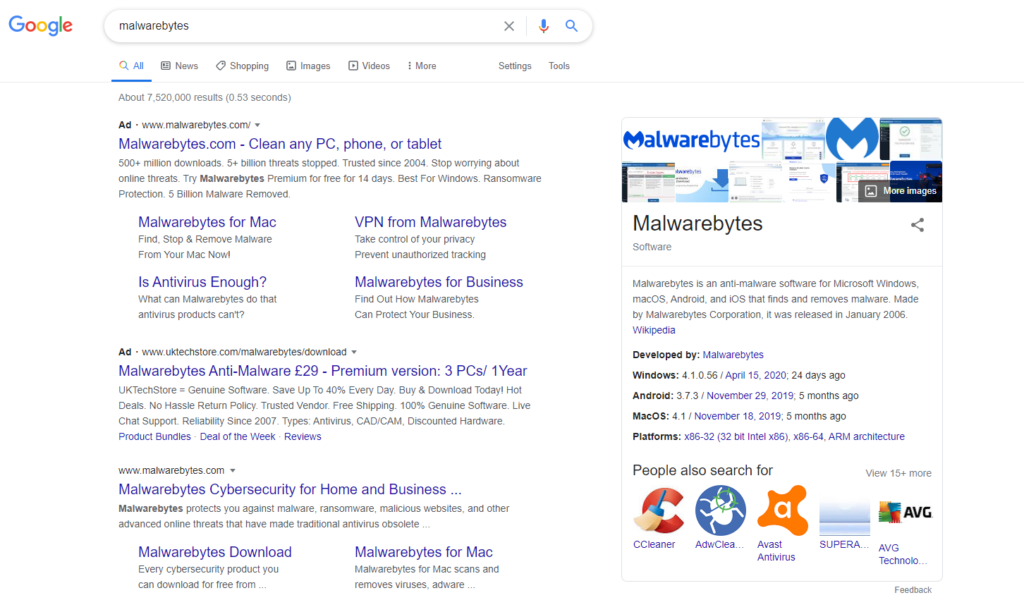
- Budget / Bid Strategy
Bidding is often one of the most complicated parts of creating a Facebook ad, and the source of a lot of stress for some marketers. It’s difficult to know how much you should spend, and how long you should let your ads run.
Sometimes, setting bidding parameters is like a guessing game. You’ll feel like you’re just estimating based on how much you have to spend each month. However, it’s important to take a strategic approach here.
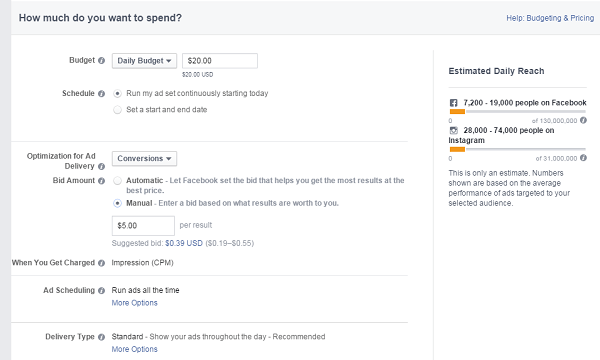
If your bids are too low, you won’t be able to reach the right audience.
If you’ve set a low daily budget, consider increasing it for a little while and see whether there’s a change in your traffic. Manage your budget carefully and keep testing with different amounts until you find the sweet spot for your campaigns.
Remember, to make the most of your budget; it helps to choose a goal for your Facebook campaign. For instance, if your objective is “traffic”, you can use landing page views as your optimization event, and Facebook will suggest what kind of budget you need.
- Social Proof
Remember, your reputation and the ability your customers have to trust you can make a big difference to your ad results.
If you’re having a hard time convincing your audience that you deserve their trust, a good option might be to add more social proof to your campaigns.
Avast, a cybersecurity company, adds snippets from case studies and reviews to its Facebook copy. This highlights what the app can do and makes it easier for customers to trust in the company’s performance.
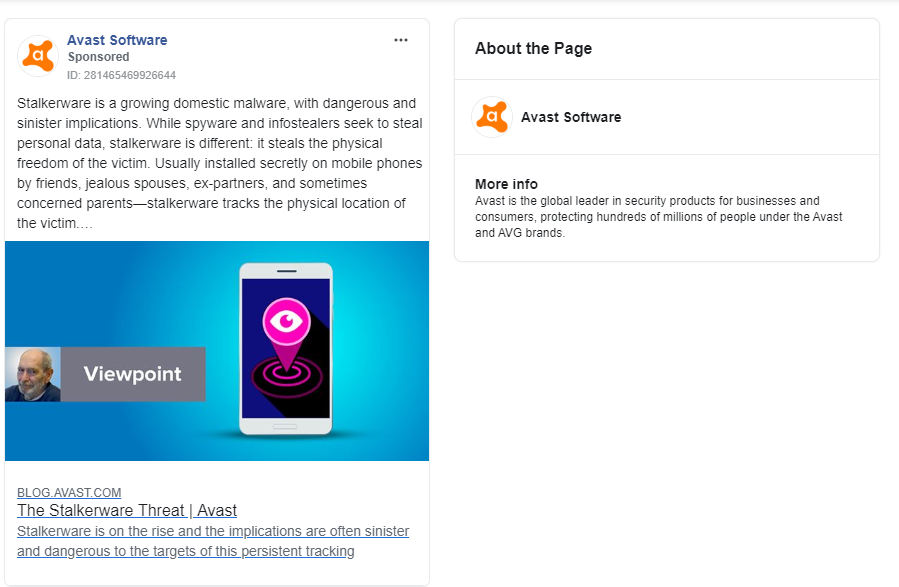
Try experimenting with your own forms of social proof.
If a case study or review seems like too much, you can consider using user generate content instead. This could mean just taking a snippet from something a customer said about you on Facebook and adding it to your campaigns.
- Timing and Geography
Facebook gives you the freedom to adjust when your ads run, according to your customer’s schedules. Every ad will have it’s peak times. Some ads will cost more to run at different times of the day or week, other ads will just grab more attention when you post them at the right time.
Think about your audience and when they’re most likely to be online.
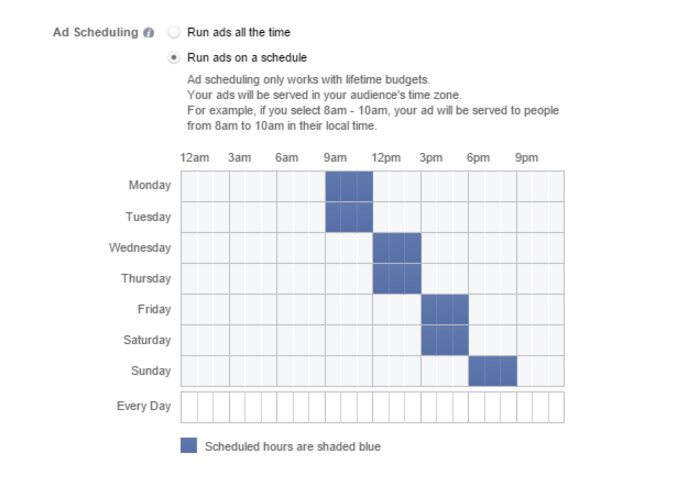
For instance, if you’re creating software for teachers, it’s unlikely that your clients will be checking Facebook during standard school hours.
It’s also worth paying attention to where your customers are located, and what that might mean to your advertising opportunities.
Don’t forget that time zones can affect the impact of your ads in different countries.
- Pixel and Audience Data
Finally, make sure that you’re using all of the tools that Facebook can offer.
This includes taking advantage of the Facebook Pixel.
The Facebook pixel is code placed on your site that helps to track conversions from Facebook ads. The more information you can collect from your pixel, the easier it is to optimize your website.
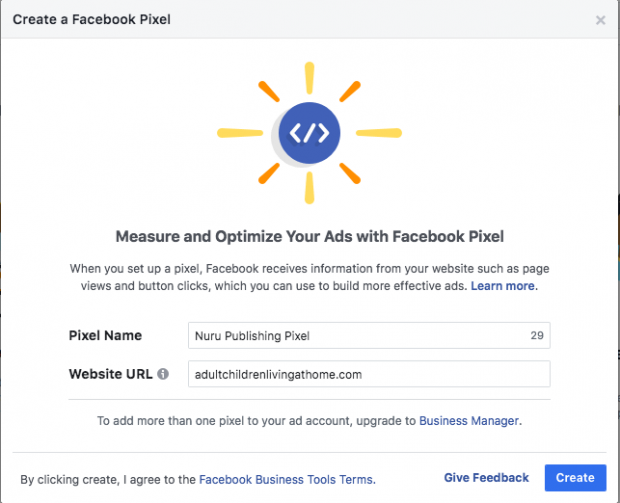
Add the Facebook pixel to your website and keep track of the results from each campaign you run. This will help to add to your audience information and give you more tools that you can use to optimize your ads in the future.
Remember, you can also test traffic with the Facebook Pixel within the Ads Manager.
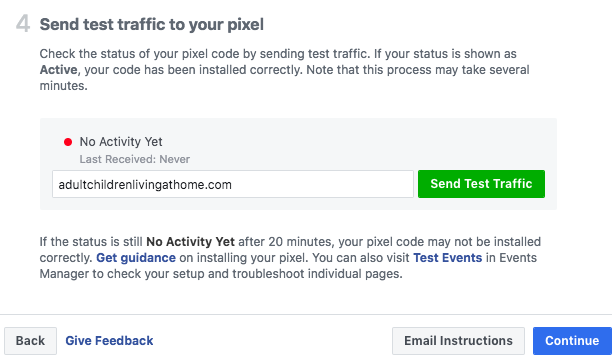
Make sure that you’re tracking the right events for your business with your pixel. Facebook gives you up to 17 standard events to choose from, and you can toggle them on and off.
For instance, you can track leads, purchases, completion of registration forms, and more. You can even examine who is adding items to their cart.
Facebook Ad Factors You Can’t Control
There are a lot of things that you can control to make sure that your Facebook ads are properly optimized. However, you can’t control everything.
Just like any kind of advertising strategy, Facebook campaigns are subject to a lot of external factors that might be outside of your wheelhouse. Here are the factors that you can’t control and what you need to know about them:
- Competition: Competition is often a good thing in the business world. Competitors push us to take our companies to the next level. They can also offer inspiration on what to do, and what not to do with campaigns. However, you can’t control the amount of competition you’re exposed to. If your industry is seeing a peak right now, it might be tougher for your campaigns to stand out properly.
- Ad costs: Even if you optimize your ads carefully, there’s no guarantee that you’ll be able to reduce your ad costs to a profitable level. If you’re working in a competitive industry, then the cost of your ads might be higher than you’d expect for a while. If you find that you just can’t profit with the cost of your ads, you might need to try different kinds of marketing.
- Seasonality: Every calendar year brings a variety of holidays and special events with it that can vary depending on geographic region. It’s essential to be fully aware of the kind of seasons and holidays that might affect your advertising. This will give you a better return on your advertising dollars. Some businesses or industries will advertise more over holidays and seasonal events. For instance, retailers often increase their ads around the Christmas period. Other companies might need to scale back around these times.
- Acts of God: There are some things that you really can’t control in this world. Floods or natural disasters that harm the economy, or a pandemic that stops people from spending isn’t within your control. You’ll need to be willing to accept that there’s always a chance that something could harm your revenue that has nothing to do with your campaign’s value.
- Economy: The economy is always changing. If the country you’re selling in doesn’t have a lot of money right now, then it’s unlikely that you’re going to make a lot of sales. Some industries suffer more in an economic downturn than others. For instance, people always need medical supplies and financial support. However, luxurious products might be less popular.
Optimize Your Facebook Ads
Facebook Ads are one of the most powerful ways to connect with a massive audience of potential customers. However, just like any other ad campaign, it’s critical to ensure that you have the right strategy in place.
Learning how to optimize your Facebook ads by altering the things that you do have control over is the key to getting the most ROI on your campaigns. Sure, you might not be able to fix every problem that your campaigns face. But we’ve given you 12 surprising ways to start improving your results immediately.
Now it’s over to you.


One Response
Great